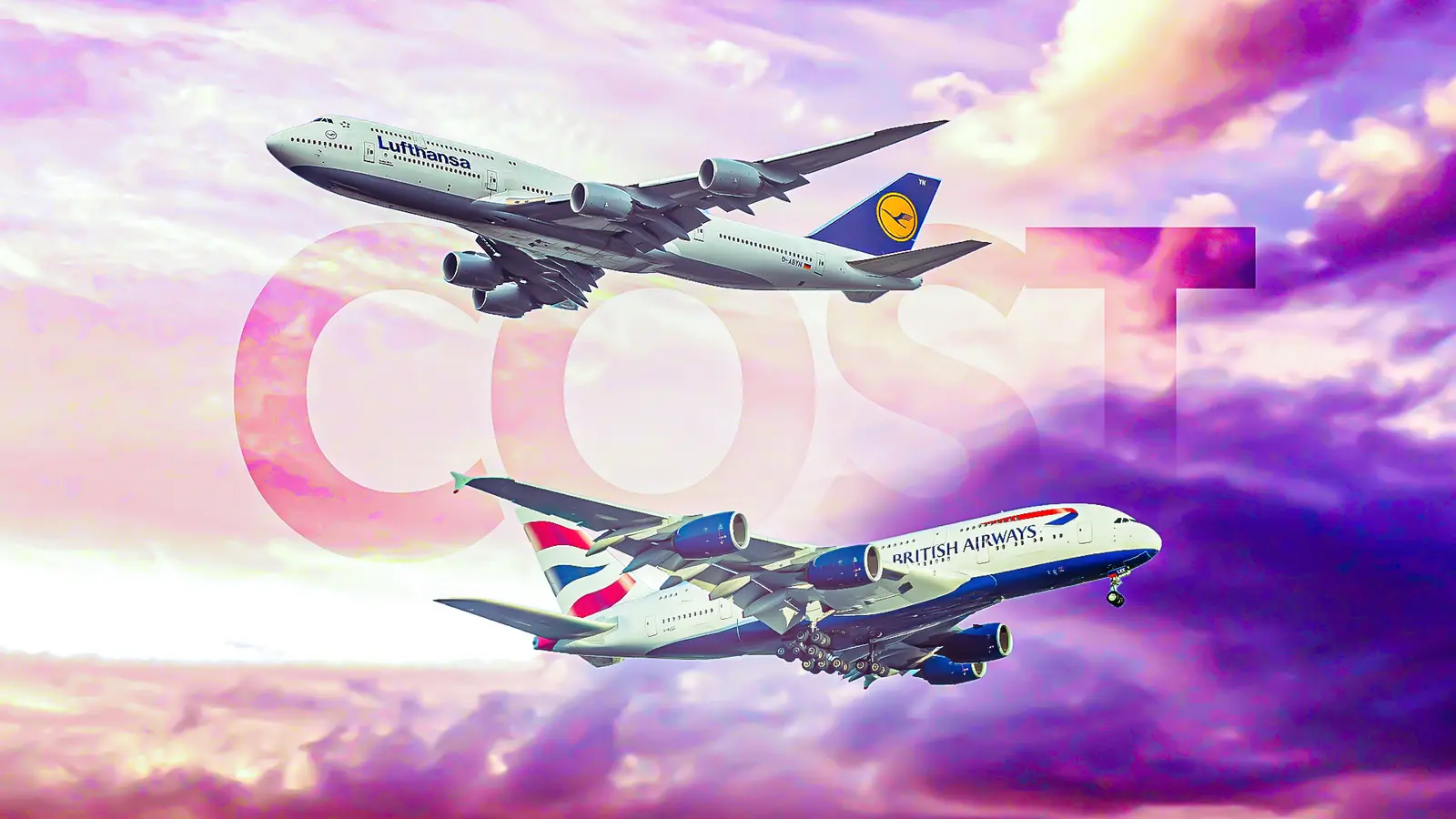Copyright Simple Flying

The Airbus A380 and Boeing 747 represent the pinnacle of long-haul passenger aviation, two engineering giants that defined luxury and capacity across generations. Yet behind the prestige and scale, the cost of buying, operating, and maintaining these double-deck and quad-engine aircraft has always been staggering. This feature breaks down the financial realities behind owning and flying the world’s largest passenger jets in 2025, revealing which program truly carries the heavier price tag. The Airbus A380 and Boeing 747 aircraft are no longer in production, but their operational and acquisition costs continue to set benchmarks for airlines and aviation investors worldwide. Airlines, charter operators, and private owners alike continue to measure the value of these aircraft not only by their capabilities but by how much it actually costs to keep them flying profitably. Understanding The True Price Of Giant Airliners The Boeing 747’s final passenger variant, the 747-8 Intercontinental, carried a list price close to $418 million at the end of production. The freighter version commanded slightly more, around $419 million when configured for cargo, though real-world transactions often came in at 40 to 50 percent discounts depending on customer history. According to Corporate Jet Investor, the Boeing Business Jet (BBJ) 747-8 variant was priced at around $418 million before customization, with annual operating costs that could exceed $20 million. These numbers place the 747 firmly within the ultra-long-haul, high-capital segment of global aviation. Airbus priced the A380 slightly higher during its production peak, with a listed price of $445 million per aircraft. Few operators, however, paid the full sticker amount. Major A380 customers such as Emirates and Singapore Airlines secured substantial discounts through large-scale orders, maintenance contracts, and long-term manufacturer partnerships. Despite this, the aircraft’s per-seat cost remained competitive, as the A380 could carry significantly more passengers than any rival. Both the 747 and A380 highlight how acquisition cost is just the beginning of a financial story. The total ownership model includes maintenance reserves, engine overhaul costs, and training programs that often exceed the purchase price over decades of use. While the A380’s sticker price was higher, Boeing’s extensive global support network offered operators more predictable maintenance costs and parts availability, narrowing the gap between the two titans of the skies. Purchase Prices And Ownership Costs Explained The purchase of either jet remains one of the most significant capital investments in aviation. As of 2025, the resale value of a passenger-configured Boeing 747-8 typically ranges from $75 million to $150 million, depending on its age and maintenance status. Cargo conversions often push resale values higher, as freight carriers continue to rely heavily on the 747’s payload flexibility. Research from Golden Epaulets Aviation places the average operating cost for a 747 at around $25,000 per flight hour, underscoring how costly the type remains even in its most efficient form. By contrast, the A380’s resale market is far smaller. Many early airframes were retired or parted out due to limited demand and high upkeep costs. However, some airlines, most notably Emirates, continue to refurbish their fleets with new interiors and upgraded systems to keep the type flying well into the 2030s. According to EplaneAI, the A380’s average hourly operating cost in 2025 sits at roughly $29,000, with total annual expenses exceeding $100 million for a heavily utilized aircraft. Aircraft Cost Comparison (2025 Estimate) This contrast reveals an important economic reality: the A380 is more expensive to operate overall, but it offers superior capacity and comfort. The 747, while cheaper to run, can carry fewer passengers and requires higher yields per seat to match the A380’s efficiency on dense routes. Ultimately, the A380’s success or failure depends entirely on an airline’s ability to keep its 500-plus seats full across long-haul markets. What Drives The High Cost Of The Boeing 747 The Boeing 747’s appeal lies in its versatility, longevity, and proven reliability across both passenger and freight roles. Yet maintaining this classic giant demands significant spending. Older variants, such as the 747-400, now face rising costs from engine overhauls, avionics updates, and structural maintenance. According to EM Airplane Journal, even used 747-400s cost between $10 million and $30 million to purchase, while total operational expenses can exceed $20,000 per hour when factoring in fuel and maintenance. Fuel remains the largest variable expense for the 747 family. The aircraft burns roughly 10 to 11 tons of jet fuel per hour, which equates to about $10,000 to $12,000 depending on global market prices. Although this consumption is higher than that of twin-engine aircraft, operators offset the cost by carrying heavy freight loads or maximizing passenger yields. The 747-8 variant has improved efficiency by up to 15 percent compared to the 747-400, but its four-engine configuration still limits cost competitiveness against modern widebodies like the 787-9 and A350-1000. Training and maintenance add further complexity. Pilots and engineers require specialized certification to operate the 747, and simulator time adds recurring expense for airlines. Crew costs are higher due to larger onboard teams, while insurance and navigation fees remain among the highest in the industry. These factors combine to make the 747 an expensive yet irreplaceable aircraft for long-range and high-capacity operations. The Airbus A380 was conceived as the ultimate flagship jet, offering unmatched passenger capacity and range. However, that ambition came with equally large financial commitments. The aircraft’s four Rolls-Royce Trent 900 or Engine Alliance GP7200 engines each require regular, expensive overhauls throughout their lifespan. According to Golden Epaulets, an A380’s ownership costs exceed $445 million, while long-term operations may total more than $200 million annually for a full-service carrier. Airlines operating the A380 must also invest in specialized infrastructure. The aircraft’s size requires reinforced taxiways, dual boarding bridges, and enlarged hangars at major airports. Only a limited number of facilities worldwide are certified to handle the A380, driving up logistics and maintenance costs. Despite these challenges, the type remains profitable for carriers such as Emirates, which achieve high utilization and strong premium demand on routes constrained by airport slots. Aviation enthusiasts often highlight the A380’s passenger appeal, but profitability remains tied to consistently high loads. Discussions on Reddit cite average flight-hour costs between $26,000 and $30,000, depending on operator efficiency. While these figures are high, they underscore the aircraft’s extraordinary comfort and capability. For airlines able to fill every seat, the economics can still work, though the model requires disciplined scheduling and sustained demand on key trunk routes. Comparing Lifetime Operating Economics When measured across two decades of service, the differences between the A380 and 747 become even clearer. The A380 offers better per-seat efficiency at high load factors, but its maintenance and infrastructure costs are more substantial. The 747, in contrast, holds residual value better and enjoys a broader support network. Data compiled from EplaneAI indicates that an A380 flying 4,000 hours per year can cost roughly $116 million annually to operate, compared to about $95 million for a similarly utilized 747-8. These figures include crew, fuel, and maintenance reserves, highlighting the narrower gap when adjusted for seating capacity. The 747’s systems are easier to service, and parts availability remains robust thanks to decades of commonality across Boeing’s widebody fleet. The A380, on the other hand, depends on fewer specialized suppliers, which increases costs for smaller operators. Over time, this difference widens as the aircraft ages and requires more thorough structural checks. In essence, the 747 remains cheaper to maintain and operate per flight, while the A380 thrives only when consistently full and efficiently rotated between high-demand destinations. Airlines choosing between the two must balance these operational realities with strategic priorities—range, cargo potential, and route density all determine whether one platform is truly more economical than the other. What The Numbers Mean For Airlines And Investors For airlines, the A380 and 747 represent an era of aviation defined by scale, luxury, and national identity. These aircraft projected prestige, yet also tested the financial endurance of their operators. The A380’s higher list price and maintenance complexity limited its appeal to a handful of major carriers. Boeing’s 747, meanwhile, evolved into a cargo powerhouse as passenger demand shifted toward smaller, more flexible jets. The shift toward twin-engine widebodies like the A350 and 787 marks a clear break from the age of the four-engine flagship. Private and VIP operators have also experienced the economic limits of these aircraft. According to Corporate Jet Investor’s BBJ Report, owning a Boeing 747 privately can cost over $2 million per month in operations alone. The only private Airbus A380 ever completed reportedly exceeded $500 million after full interior customization. Even for billionaires and heads of state, the cost-to-benefit ratio of such aircraft has proven impractical compared to newer, fuel-efficient long-range business jets. The future of both aircraft types lies in niche roles rather than mainstream fleets. Airlines that continue to operate them will do so out of necessity or brand alignment, not purely for financial reasons. The A380 and 747 will remain icons of a unique era in aviation, but they also serve as a financial reminder of how efficiency, sustainability, and flexibility have come to define modern air travel economics.



